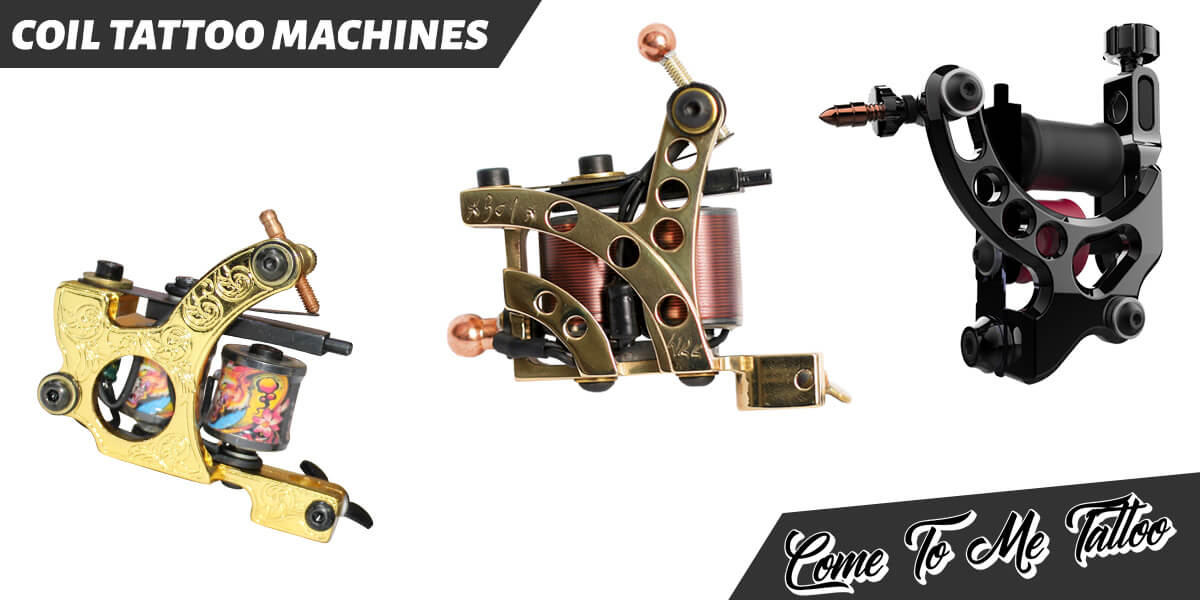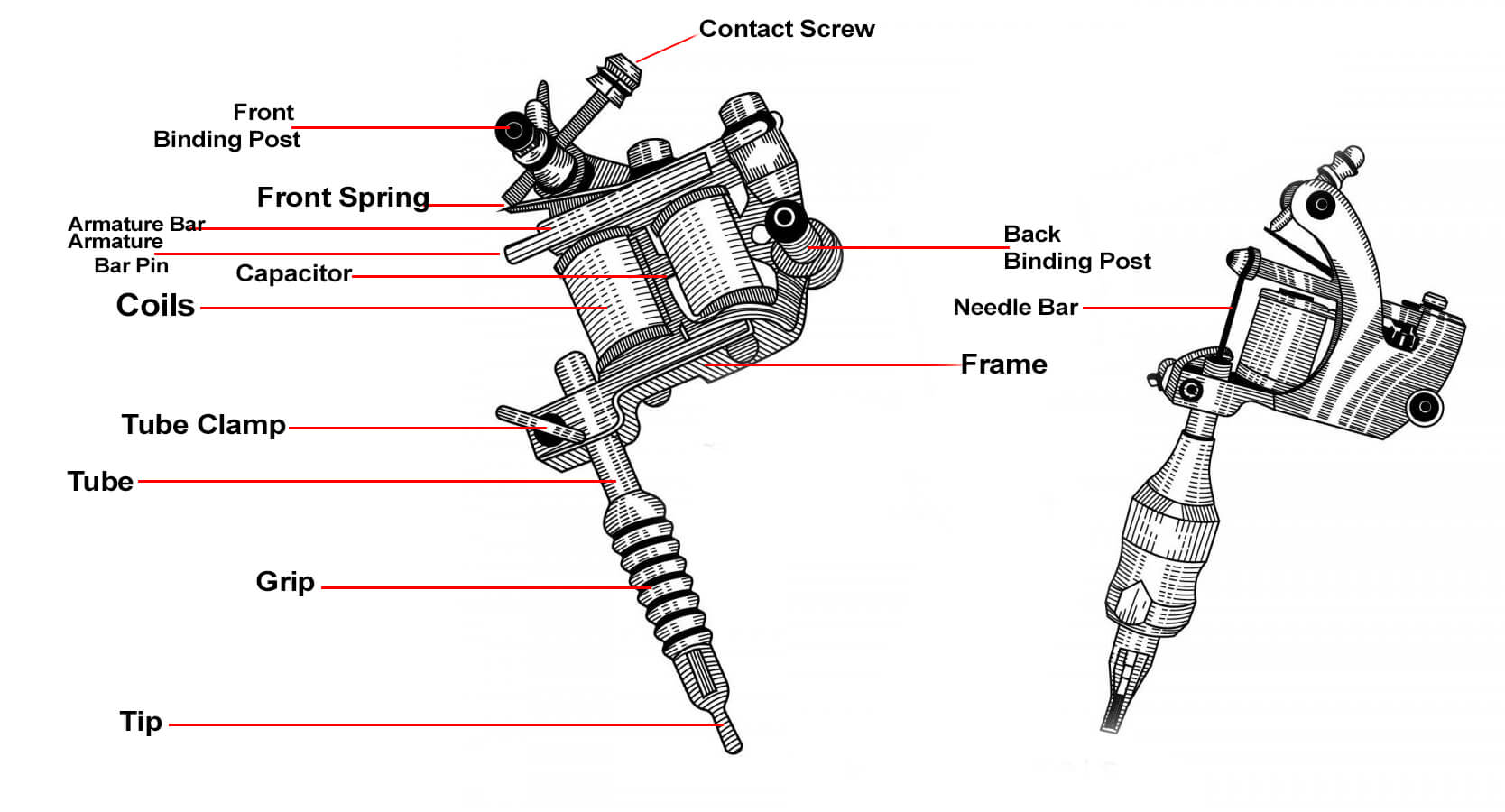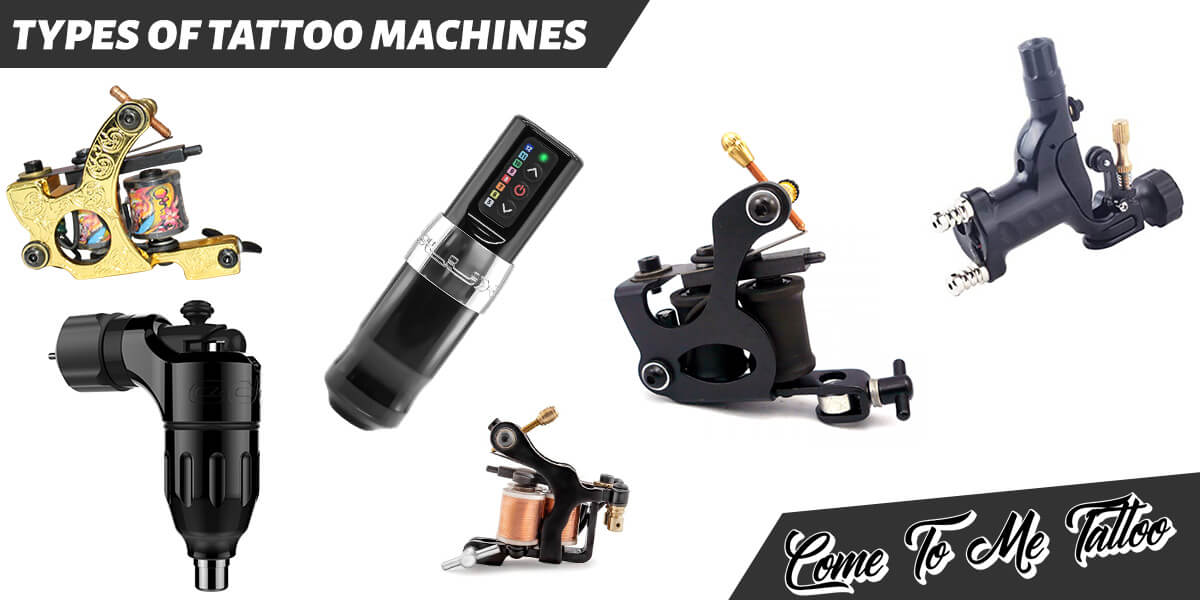Types of Tattoo Machines
As the tattoo industry develops, so does the tattoo equipment. Including different tattoo machines. If the first tattoo machine – coil – worked with the mechanism of magnetic coils, then, popular today, the rotary type of tattoo guns, works with the help of an eccentric. Differences in the design, construction and operation of these and other different types of tattoo guns in detail – below.
Rotary Tattoo Machines

The basis of rotary tattoo machines is an eccentric, which converts the rotary motion of the motor in a reciprocating motion of the tattoo needles. That is, this type of tattoo machine appeared with the advent of small and light, but powerful and revolving electric motors.
The construction of the rotary tattoo machine consists of:
- The frame, that is, the supporting part of the structure. In most cases aluminum alloys are used for the frames of rotary tattoo machines, but recently durable polymers are gaining popularity.
- The electric motor is the power mechanism. Manufacturers of rotary tattoo machines prefer to use electric motors of companies that specialize in the production of small current electric motors.
- The eccentric is a cylinder with a bearing and a displaced rod-boy fixed in it, which converts the rotational motion of the motor into reciprocating motion.
Thus, the structure of the rotary tattoo machine is provided so that to work with it was not only convenient, but also pleasant.
It turns out that, on the one hand, the design of the rotary device is convenient to use and works quietly, but on the other hand, the eccentric creates not only longitudinal but also transverse movements. The former are just what you need, and you have to fight the latter a lot. If the needle moves not only back and forth, but also vibrates to the sides – it will only smear the pattern. With varying degrees of success with this problem rotary tattoo machine manufacturers cope differently. But generally, let’s say this problem is solvable, considering the popularity of rotary tattoo machines.
Based on the above, we conclude that rotary tattoo guns have both advantages and disadvantages:
- An important advantage of the rotary device is its versatility for contouring and tattooing
- High efficiency – at low energies produce efficient results
- Quieter than induction units
- Less vibration
- Lower weight
- Most models are designed in a very ergonomic way so they are easy to hold
- Minimal trauma to the skin
- The possibility of individual adjustment of the stroke (more about this below)
- High price
- Relative to coils – more fragile construction
- Expensive repair
- Depreciation of the motor
- Specific tasks (e.g. clearer contouring or work on very dense skin) are better handled by the coil unit
Nowadays rotary machines are much more popular than induction machines, because their principle of operation allows to make improvements and modernize machines, making the work of tattoo artists more effective, while induction has not changed for more than 100 years. Also, some rotary machines have different or adjustable needle stroke. The long stroke (over 4 mm.) is more suitable for lines, the short stroke (1.8 – 2.5 mm.) for smooth transitions and shadows, and the medium stroke (3.5 – 4 mm.) is considered universal and suitable for all types of work.
Types of rotary tattoo machines
Rotary tattoo machines differ in their internal design:
-
Direct Drive. The tattoo needle is attached directly to the eccentric pin, which is attached to the rotary motor – no other additional mechanisms. Because of the lack of additional needle stabilization, they are more suitable for coloring and shading than for contouring.
-
Slider. Inside the design, there is an additional mechanism for greater needle stabilization: the slide. A bearing or eccentric drives the slide mechanism, then a return spring allows the slide to slide smoothly up and down, ensuring a stable needle stroke.
-
Pistonsmith. Technically a more complex mechanism than the slider: instead of a spring, a whole piston with a spring.
-
Hybrid. They got their name because of the similarity of the mechanism with the coil tattoo machine: they also use an armature bar to stabilize the needle.
-
Pen. A super-popular type of tattoo machine today due to its convenient design and construction. Wireless tattoo pens are especially popular. The mechanism uses a disk with paddles or a so-called drunken bearing to stabilize the needle. Note that such designs are more expensive both in terms of purchase and in terms of maintenance and repair. By the way, the pen is the best rotary machine for permanent makeup, as it is very convenient to hold in your hands, and therefore to draw the fine details.
-
Rocker. A very rare type. There is a long beaker parallel to the body above it, which is essentially an analog of the armature bar.
Coil Tattoo Machines

As mentioned above, the induction mechanism of the tattoo machine is actuated by the attraction and repulsion of the armature bar by an electromagnet. The movements of the armature bar are transmitted to the needle, which is directly connected to it.
Note! The patent for the first coil tattoo machine was obtained January 30, 1929 by Detroit tattoo artist Percy Waters.
Let’s look at the design of this type of device:

-
Frame. As in the previous case, it is the base on which all the elements of the mechanism are assembled. As a rule, they are made of metal – steel, copper, various alloys. It is important that the frame was strong, but at the same time lightweight, as coil tattoo guns are usually not lightweight.
-
Coils. “Motor”, electromagnets with steel cores. Depending on the number of wire layers differ in the number of turns: the more turns in the coil – the more powerful electromagnet.
-
Capacitor. Its main function is spark-quenching (it accumulates excessive charge).
-
Armature Bar. Steel magnetic element attracted by the coils. It is mounted on a spring, which makes it return. This is how the oscillating movements necessary for the operation of the tattoo machine are created.
-
Two springs. One of them fastens the armature to the frame, and the other one acts as one of the contacts. The stiffness of the springs affects the way the machine works.
-
Contact Screw. Silver or copper screw to adjust the frequency and depth of punctures.
Together, this design allows you to fine tune your tool and perform very specific tasks according to your needs. The uniqueness of the settings allows the tattoo artist to rely on the accuracy and correct nature of his instrument.
Among the important positives and negatives of this type of tattoo machine is worth noting:
- Low price
- Precise adjustment of operating parameters
- Stable operation and high performance
- Durability and reliability in operation
- Easy to service.
- Strong noise and intense vibration
- Heavy weight – arm gets tired faster
- Inability to set up the machine by yourself without some technical knowledge
- Requires a strong and reliable power supply.
Types of coil devices
A coil tattoo machine is always customized for a specific task, either contouring or coloring, and this is what allows it to work as efficiently as possible. For this reason, coil tattoo machines are divided into liners and shaders.
Liner
Coil liner tattoo machines are still considered the best in working with contours. Its goal is to “ink” the pigment into the skin as quickly as possible, without it spreading under the skin. And the liner is also well-balanced and usually has a low weight.
Shader
Powerful coils for dense coloring and smooth shadows. It’ s a great option when you need to pigment a large area quickly and efficiently. The design of the shaders is built in such a way as to pierce the skin more gently and stay in it longer, so that the tattoo ink spreads out evenly, creating a dense coloring. It is not possible to make a contour with such a machine because the line will be thick and blurry. Shaders also have a large number of coils in their coils.
Tattoo Machines with Commutatorless Motors
In addition to the two types of tattoo machines described above, there are still rare, but gaining in popularity, new type of tattoo machines with commutatorless motors. They operate at ultra-low speeds. At the same time, commutatorless motors are a real innovation in this field, so far these tattoo machines are expensive and rare, although they are very light in weight.
Other Classifications
Depending on the manufacturer, machines can be:
-
Chinese is a cheap device, which, as a rule, often break down, and worse than professional devices when it comes to service and maintenance (but this is not always the case). This option should be considered only if it is a proven brand (then it is assumed that the device will be delivered with a warranty and will be serviced), or if you need a cheap device for training and practicing skills.
-
Homemade are self-made devices.
-
Professional are devices of a popular manufacturer, with a warranty and service. Such machines are tested and subjected to strict quality control of materials, components and assembly.
FAQ
What type of tattoo gun is best for beginners?
In fact, you, as a beginner, should try to work with different kinds of tattoo machines. Many people say that the coil ones will suit beginners better because of their affordability. In this case, you will need to buy two machines of this type at once and understand in detail the settings of the device. On the other hand, rotary machines are easier to use and maintain, but they are more expensive and more difficult for a beginner to “feel” their work.
How many tattoo machines do you need?
Buying a rotary tattoo machine, you will most likely need one device, while a coil tattoo machine needs two (liner and shader). But you may need additional devices for specific tasks in the future.
Conclusion
What kind of tattoo machine is the best? The answer is simple. Each tool is good for its task, and attempts to make do with one-size-fits-all solutions will only lead to mediocre results. A tattoo artist needs to have both coil and rotary machines in their arsenal of tools. It is necessary to learn to understand for what kind of work what machine is better to use, and this understanding can be given only by your personal experience which with time has turned into what is called an author’s handwriting.

